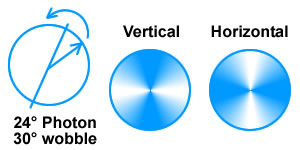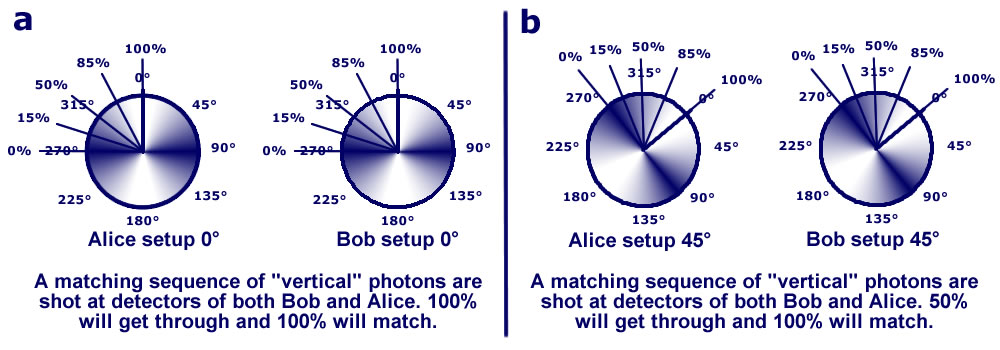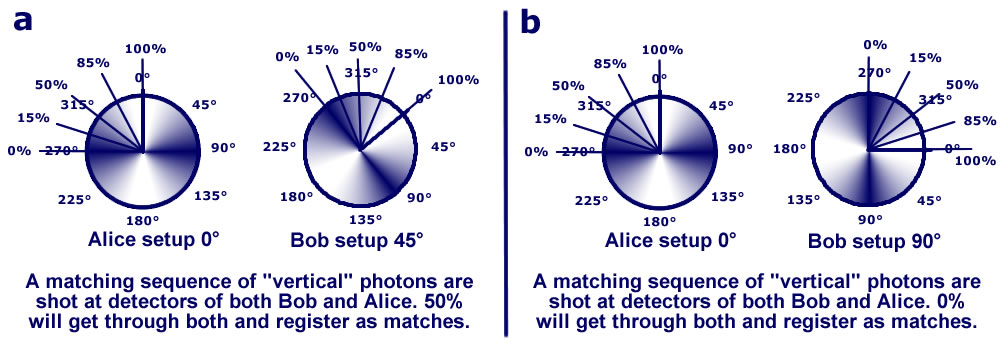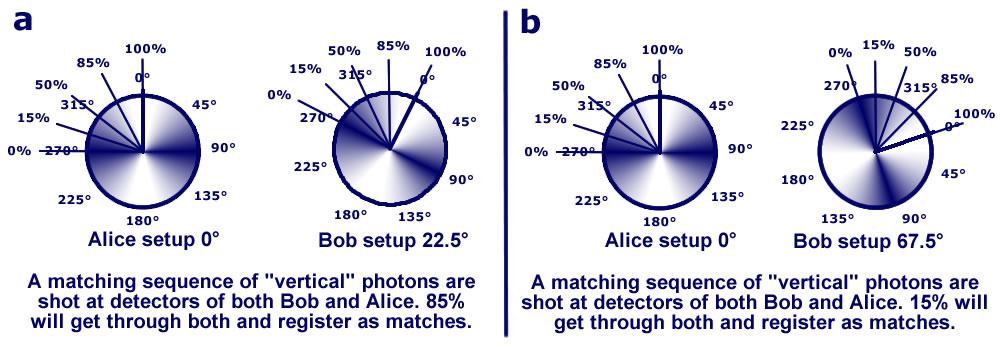Alice and Bob - Entangled photons
Entangled photons, nonlocality and Bell
inequalities
in the undergraduate laboratory.
Dietrich Dehlinger, M. W. Mitchell
(http://arxiv.org/PS_cache/quant-ph/pdf/0205/0205171v1.pdf)
The experiment described and performed by Dehlinger and Mitchell centers around the detection of
photon pairs at two different locations. The polarization of a photon stream is first
fixed in a specific direction from vertical with a linear polarizer, then the phase of one
component is fixed with a birefringent quartz plate. The photon stream is then directed at
beta barium borate (BBO) crystals that cause a small fraction of the laser photons to
spontaneously decay into photon pairs with the same total energy as the original photon (a
process called spontaneous parametric downconversion).
Two single-photon counting modules (SPCMs), are used to detect the photons.
One detector is traditionally named Bob and the other Alice. Because the photons of a downconverted pair are produced at the same time they
cause coincident, i.e., nearly simultaneous, firings of the SPCMs. Simultaneous firings are considered coincidences
if they occur within 25 nanoseconds of each other. The experiment is done by recording the number of coincidences that occur for various settings
for the measurement angle of Bob and Alices detectors. The number of coincidences at different observer angles is what must be modelled
correctly as a “local realistic hidden variable theory” (HVT).
Dehlinger and Mitchell go on to obtain the results a) on the right. The open circles representing Alice at 0° and Bob at 0 to 180°.
The closed circles represent Alice settings at 45° and Bob at 0 to 180°.
In the authors model, each photon has a polarization angle λ.
When a photon meets a polarizer
set to an angle γ
, it will always register as Vγ
if λ is closer
to
γ than to γ
+ π/2, i.e.,
if |γ
− λ| ≤ π/4 then vertical
if |γ
− λ| > 3π/4 then vertical
horizontal otherwise.
Represented by icons, this model produces a correlations chart,
shown as b) on the right, clearly different from the experimental results shown as a).
The angle 22.5° shows the most difference between the model and quantum physics. Dehlinger and Mitchell
choose this angle to analyse in detail and show that their experimental results match with quantum physics.
In their words "Our HVT is very simple, and yet it agrees pretty well with quantum mechanics. We might
hope that some slight modification would bring it into perfect agreement.".

Animated Physics derives the linear photons as not only having a specific "average" direction,
but also as having a "wobble" or "instantaneous" direction.
Represented as icons, photons present a more
"fuzzy" picture of their polarization. The sample 24° photon, with a 30° wobble, will
 most of the time be picked up as a vertical, but sometimes when the angle is over 45°, it
will be picked up as a horizontal.
In general, wave plates will turn both the average and the instantaneous
orientation, but the path of the photon through calcite will be determined by
the instantaneous orientation.
The graph on the right demonstrate that this model matches the predictions
of experiment. In fact, this follows (and verifies) the same cos(γ
− λ)²
rule that is used by quantum mechanics.
most of the time be picked up as a vertical, but sometimes when the angle is over 45°, it
will be picked up as a horizontal.
In general, wave plates will turn both the average and the instantaneous
orientation, but the path of the photon through calcite will be determined by
the instantaneous orientation.
The graph on the right demonstrate that this model matches the predictions
of experiment. In fact, this follows (and verifies) the same cos(γ
− λ)²
rule that is used by quantum mechanics.
Lets start the experiment. To start, we test that
Alice and Bob get maximum matches with both set at 0°and adjust to maximize when both are at 45°.

We leave Alice at 0° and try Bob at 45° then 90°

Try a difference of 22.5° then 67.5° between Alice and Bob
